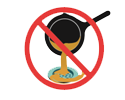Get the facts on how construction waste can affect sewer lines, storm drains, and property owners.
Make sure not to clog your drains with F.O.G.!
Illegal Dumping
Illegal dumping found in the City of Redlands sewer lines
Recently the City of Redlands Collection System workers found construction waste in the sanitary sewer.
The first discovered incident occurred on May 19, 2018. Material, similar to that in the photo above, was blocking the sewer line at Ford Street and South Avenue. This material blocked the sewer system’s flow and caused a sanitary sewer overflow. The crew worked for six hours to clear the blockage and remove all of the material from the sewer to prevent another blockage.
The second discovered incident occurred on August 15 2018, at Maple Avenue and Dearborn Street. The material shown above was found in the sewer line during a routine cleaning. The collection system crew was able to divert potential sanitary sewer overflow by cleaning and collecting all of the material from the line.
The third discovered incident occurred on August 28 2018, at La Mirada Drive and Wabash Avenue. The material shown above was found in the sewer line during a routine cleaning. The collection system crew was able to divert potential sanitary sewer overflow by cleaning and collecting all of the material from the line.
If anyone has any information that may be helpful in preventing future incidents like these please contact ktra@cityofredlands.org.
Construction Waste
What’s the Problem?
Construction sites have the potential to contribute to pollution in the storm drain system and to cause problems for the sewer system.
Material such as concrete, plaster, sand, gravel, wood remnants, sawdust, chemicals, solvents, and other construction debris can make its way into the sewer and storm drain system in various ways.
- Failure to protect storm drains and gutters
- Failure to protect sewer drains and cleanouts
- Failure to protect construction material and debris from wind and rain
- Washing concrete waste and other solids down the sewer and storm drain system
- Washing down construction areas
- Draining chemicals, paints and solvents down the sewer and the storm drain system
The owner and contractor can be held liable whether the discharge to the sewer or storm drain system is unintentional or intentional.
Why?
Discharges of construction waste into the sanitary sewer or the storm drain system are a violation of federal & state laws and county & city ordinances. Homeowners, businesses and property owners may be held responsible and required to pay for clean-up cost and could be subject to fines and legal action.
These types of illegal discharges also harm the environment by polluting our waterways, destroying plants, harming aquatic life, and affecting the water quality of our groundwater and surface waters.
Illegal discharges also contribute to sewer back-ups that lead to expensive plumbing bills, costly clean-up and damage to homes, businesses and private property. Also, taxpayer money is used to pay for city resources when responding to illegal dumping calls.
In some cases, illegal discharges lead to structural damage and explosive situations in the sewer and storm drain system. This type of situation can also cause physical harm to the public and to city workers.
“PROTECTING DRAINS IS THE KEY”
Construction Waste Solutions
Preparing before construction
- Arrange for construction waste disposal or recycling before you start
- Schedule work during dry weather if possible
- Protect drains that lead to the sanitary sewer
- Protect storm drains and gutters
During Construction
- Monitor construction activities to ensure prevention measures are kept in place at all times
- Minimize waste by not ordering more than is needed
- Sweep up construction debris instead of washing down
- Never wash out wheelbarrows, or other equipment and tools, into the sewer or storm drain system
- Cover loose construction material or debris to protect from wind and rain
When the job is done
- Make sure all construction waste is properly disposed of or recycled.
- Remove preventative measures from the sewer and storm drain systems
Resources
Contact Solid Waste Customer Service regarding:
- Roll-Off dumpster services
- Construction Waste Disposal
- Hazardous Waste Disposal
- Household Hazardous Waste Disposal
- E-Waste
Report all Illegal dumping or discharges to Utilities Customer Service.
If you see active dumping outside of normal business hours, please contact the Redlands Police Department Non-Emergency Dispatch number.
Fats, Oils, and Grease (F.O.G.)
 Help FOG Man fight F.O.G. in your drains!
Help FOG Man fight F.O.G. in your drains!
 Fats, Oils and Grease clog up the drains in your home. Simple FOG fighting tips will save you money on expensive plumbing bills and messy drain blockages. And remember, NEVER pour FOG down the drain!
Fats, Oils and Grease clog up the drains in your home. Simple FOG fighting tips will save you money on expensive plumbing bills and messy drain blockages. And remember, NEVER pour FOG down the drain!
SUPER HERO TIPS TO SAVE THE DAY: 
- FOG fighters always scrape greasy food into the trash! This keeps out drain clogging bad guys.
- Placing used oil in an empty can always saves the day! Throw the can into the trash when it is full.
 Help Water Woman prevent clogs in your drains!
Help Water Woman prevent clogs in your drains!
WHAT NOT 2 FLUSH